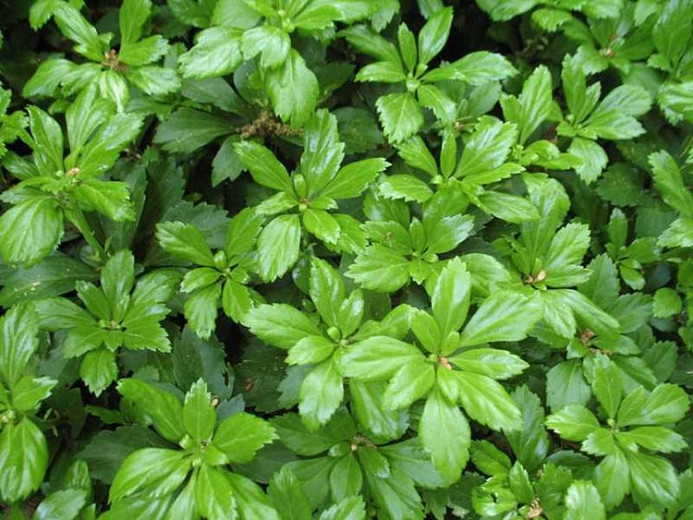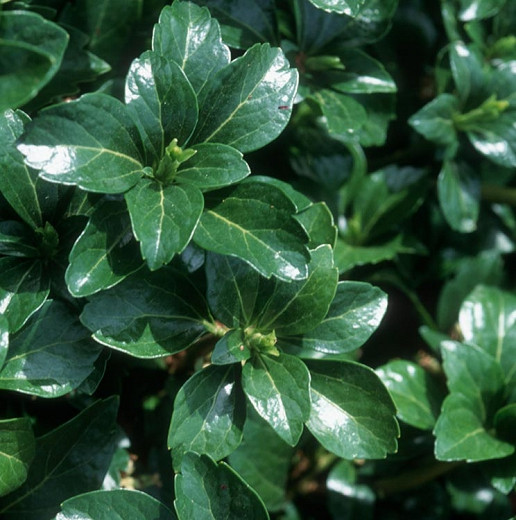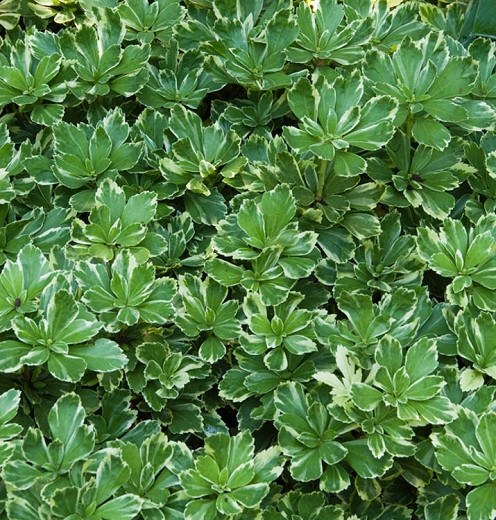Pachysandra procumbens (Allegheny Spurge)
Pachysandra procumbens (Allegheny Spurge) is a shrubby ground cover which spreads via underground rhizomes to form a dense carpet of blue-green leaves marbled with silver and purple. The leaves are arranged in circular patterns around fleshy, erect stems. The foliage is usually deciduous in USDA Zones 5 and 6 but semi-evergreen to evergreen in Zones 7 to 9. Fragrant white flower spikes, 2-4 in. long (5-10 cm), appear in early to late spring, often before the new leaves emerge, but the added value of this plant is its attractive foliage. Allegheny Spurge is an excellent ground cover for shady areas. It is considered more attractive than the Japanese Spurge (Pachysandra terminalis) and less aggressive. This woodland plant performs well in a variety of soils from moist to dry as long as it is growing in partial to full shade.
- Grows up to 6-12 in. tall (15-30 cm) and 12-24 in. wide (30-60 cm). Spreads slowly to form colonies.
- A part shade to full shade lover, it is best grown in acidic, organically rich, medium moisture, well-drained soils. Too much sun yellows the foliage and causes poor growth. Drought tolerant once established. Can be evergreen if protected from cool winds.
- Perfect for the shade gardens, as a groundcover or underplanting shrubs. Great for banks and slopes, woodland gardens.
- A hardy, low-maintenance and forgiving perennial, it is considered by many to be very deer resistant.
- No serious pest or disease issues. Keep an eye out for leaf blight, aphids, slugs, scale and mites.
- Propagate by division in late summer or early fall. Softwood cuttings may be taken in spring or early summer.
- Can be toxic and sometimes fatal to animals if eaten.
- Native to the southeastern United States.
Requirements
| Hardiness | 5 – 9 |
|---|---|
| Climate Zones | 2, 2A, 2B, 3, 3A, 3B, 4, 5, 6, 15, 16, 17 |
| Plant Type | Perennials |
| Plant Family | Pachysandra – Spurges |
| Exposure | Partial Sun, Shade |
| Season of Interest | Spring (Early,Mid,Late)Summer (Early,Mid,Late)FallWinter |
| Height | 6" – 1' (15cm – 30cm) |
| Spread | 1' – 2' (30cm – 60cm) |
| Spacing | 24″ (60cm) |
| Water Needs | Average |
| Maintenance | Low |
| Soil Type | Chalk, Clay, Loam, Sand |
| Soil pH | Acid, Neutral |
| Soil Drainage | Moist but Well-Drained, Well-Drained |
| Characteristics | Evergreen, Semi-Evergreen |
| Native Plants | United States, Midwest, Indiana, Northeast, Pennsylvania, Southeast, Alabama, Florida, Georgia, Kentucky, Louisiana, Mississippi, North Carolina, South Carolina, Tennessee |
| Tolerance | Drought |
| Garden Uses | Banks and Slopes, Ground Covers, Underplanting Roses and Shrubs |
| Garden Styles | City and Courtyard, Informal and Cottage, Prairie and Meadow |




